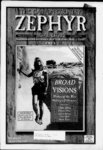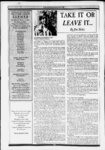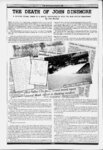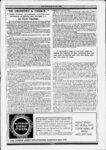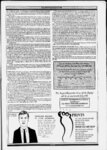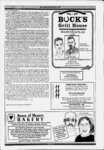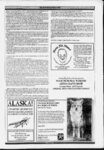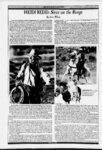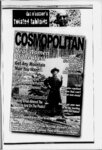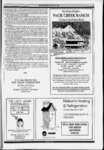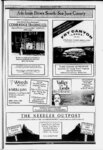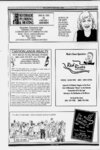| OCR Text |
Show & v .'.v..'yAw.vwy.v T f' iL- v - V U rs i fc- -- 1 bs.V 'J I yfP- .j.v.y.sv.j.j.vv.j.v.v.i.v.v.j.v.yc - preservation and tourism will be debated even further as adventure travelers are lured to Southern Utah and other wild places by glossy photographs and adventure magazine articles. X ;v.v.v.vs i ,v.v.sv.;.v.y.v.v.v.;.v.v.v.;.v.v.v.v.v.v.v.v.v.v.v.v.v.v.;.v.v.:.v.v.; &$St3M3i$2 J H '..v..r.w.v.V.w..v.vXv.v.v.v.v.v.vXvr.v.v.iW.'.v.v..w.v..v.w..vA'X.vw.v.v.v.sv.v.sv , s: k X'- - Sincerely, Matt Baker Provo, Utah Jt a ..vAViV.v.v. Dear Jim: into the This year the Sierra Club will lead more than 320 Sierra magazine will also continue publishing articles world's wild places. "Amble through uncrowded, scenic wilderness," as in the encouraging people to environmental J anuary February "Adventure Travel Issue" of the organization's magazine. adventurers This promotion of tourism is seen by many environmentally-minde- d as a conflict of interest for an organization that, in the same magazine, promotes wildlife and wilderness preservation. "'Conflict of interest' implies you can't do both," says Joan Hamilton, Editor-in-Chiof Sierra. "I don't agree with that, but there is certainly a tension." Although Sierra encourages readers to explore the natural environment, Hamilton said from her office in San Francisco, "We try to keep them off the beaten path. The Tetons and the Wind River Mountains in Wyoming, for instancy have enough backpackers without our adding to the crowd. But Baffin Island and Silver Peak and the Taku River in our March April issue are far from overrun with tourists. And two of them (Taku and Silver Peak) are in need of protection." Publishing articles and photos of places that are in need of protection and don't receive large numbers of visitors can be beneficial for environmental reasons, says Hamilton. But seeing articles about places in a magazine of nearly 500,000 is exactly what upsets some outdoor adventurers who have considered many places in Southern Utah their private playground for most of their lives. "I get upset when I see the route to a sacred place in Southern Utah detailed in a magazine," said Steve Peterson, a professor of outdoor literature at Snow College in Ephraim, Utah. In contrast to Sierra's philosophy, Peterson believes that magazine editors should s. "Keep the masses focused encourage travel in places that are already tourist in the busy spots, near Coke machines and flush toilets," says Peterson. "Let the not following some author step by step. adventure tourists go out for adventure-tha- t's I suggest the outdoor editors stick to Temple Square and leave the truly sacred places as secrets." John Muir, founder of the Siena Club, believed that when people experienced wilderness, they became allies in the fight to protect it This is still Sierra's basic philosophy, says Hamilton. Sierra has been one of the strongest forces in promoting the designation of 5.7 million acres of Utah as wilderness. But the "5.7 Wild" logo has appeared in Sierra mostly to promote travel in Southern Utah. In the March April 1997 edition of Sierra, the logo was used to advertise more than 40 guided trips in Utah. Yet the same issue touted a list of things readers could do to help preserve Utah's wilderness. One of the ways: "Visit Utah on a Sierra Club outing." Richard West Sellars, a historian with the National Park Service, addressed the conflict between preservation and promotion of tourism in his book Preserving Nature in the National Parks. He wrote that the paradox of our national parks is that "development for public use and enjoyment can foster nature preservation on large tracts of public lands" Sellars laments that tourism has hurt our national parks. "The push and shove of hordes of tourists and the concomitant problems eclipse the unalloyed pleasure that earlier generations surely experienced." This conflict of interest, or "tension," as Sierra's Hamilton calls it, between group-expeditio- Dear Jim: ns Since The Zephyr is now publishing poetry, here's my s' worth: Wild Turkey 106-year-- old A wild turkey I want to be. I'll hang around Close to the ground. ef little-know- n two-bit- I'll eat wild berries And smoke chokecherries. To squawk and gobble My only jobble. (Please be sure to send my way all the literary agents and publishers who are sure to call) Sincerely, Chinle Miller Stock Tank, Utah NOTE: Please. .mII would be poets. Do not bombard me with verse. Chinle caught me at a weak moment... S hot-spot- Editor's note: We belatedly received the following two letters in response to Owen Severances " presentation of the second annual Donald Currey Award for Environmental Insensitivity." Mr. Severance then responds to his critics...JS Dear Editor: I wish to amend information that has allowed your paper to heap just a little more Donald on he either or deserves. Yes, it was his than earned Currey responsibility research that led to the Forest Service cutting down the oldest tree yet found. But it was not because he didn't attempt to core the tree as Mr. Owen Severance states. I think that if he were to meet him, he would find that Donald Currey is not or lacking remorse over this issue. Bristlecone Pines are incompetent, difficult trees core and have a reputation for breaking core drills. Indeed, to gnarly, he had attempted several times to core the tree, breaking each of the core tools he (at that time a poor graduate student) had brought from North Carolina. When he stopped in Ely and asked to borrow a core drill from the local Forest Service professionals, they insisted that there were plenty more of those trees up there. Why not just use their chain saw and cut it down? Those Monday Morning quarterbacks among us know why, but at the time there was a need for the basic dendrochronology and no way to know this one tree in the forest was "Methuselah." Rather than Currey, it seems that the U.S. Forest Service, James Watt, or Ronald Reagan would be the appropriate honoree for the Environmental Insensitivity Award that Mr. Severance presents annually. They continue to this day to practice the same BROWNTROUT PUBLISHERS P.O. Box 280070 San Francisco, CA 94128-007- 0 Browntrout was founded in 1986 as a book and calendar publisher. Our success with calendars (almost 500 titles in 1998 the largest in the country) has kept us very busy. In 1994 we launched our book program. The books we publish fall into two categories: photographic portfolios and trade books. 800-777-78- 12 www.browntrout.com Actual cartoon of publisher Marc Brown EITHER... at the moment he had yet another great calendar idea... OR... at the moment someone said, "Uh...Marc... you've got egg yolk on your chin. Look for many of our books and calendars at: Back in LL JJkJLJlUJF of Beyond Moab or call us direct. - V oraVu. |
